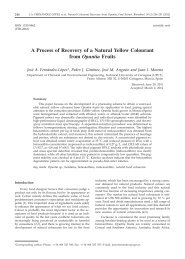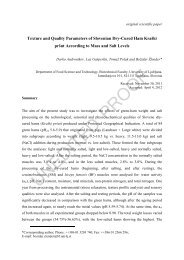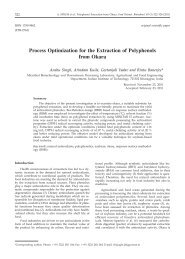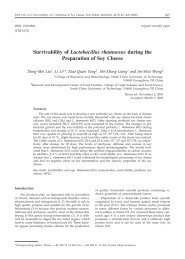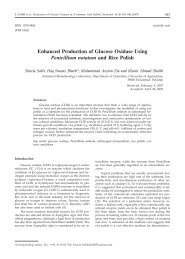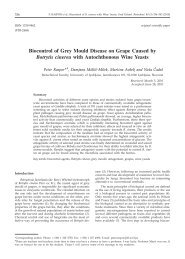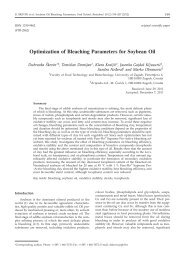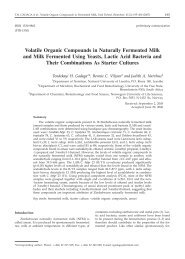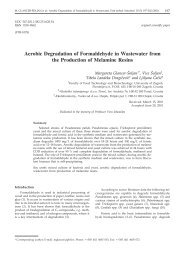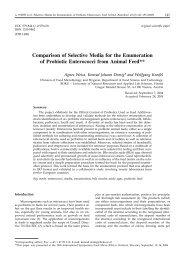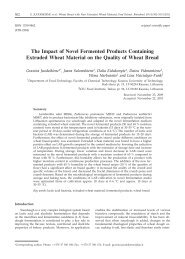Surfactin - Food Technology and Biotechnology
Surfactin - Food Technology and Biotechnology
Surfactin - Food Technology and Biotechnology
- No tags were found...
You also want an ePaper? Increase the reach of your titles
YUMPU automatically turns print PDFs into web optimized ePapers that Google loves.
122 N.S. SHALIGRAM <strong>and</strong> R.S. SINGHAL: <strong>Surfactin</strong> – A Review, <strong>Food</strong> Technol. Biotechnol. 48 (2) 119–134 (2010)accumulate in the lower dextran-rich phase <strong>and</strong> surfactinin the top phase. This was useful when setting upextractive bioconversion fermentation, as the cells wereeasily recycled to the fermentor. The polymers could bereused after the recovery of surfactin. It was also observedthat surfactin caused an end product inhibition<strong>and</strong> resulted in lower yields. With the aqueous two--phase system, the partitioning between the cells <strong>and</strong>surfactin lowered the contact of surfactant with the cells,<strong>and</strong> thus increased the production <strong>and</strong> minimized theend product inhibition. This method could be appliedfor continuous fermentation as well.Airlift reactorNoah et al. (23) reported the use of potato processeffluent for the continuous production of surfactin by B.subtilis. Potato process effluent consists of indigenousbacteria that outcompete the growth of B. subtilis. Duringbatch operation in shake flasks, they observed surfactinto remain in the liquid, assisting B. subtilis in overtakingthe indigenous bacteria. The batch culture wasperformed in an airlift reactor (3 L) with potato starch,where surfactin was stripped out into the foam <strong>and</strong> therewas better transfer of O 2 into the liquid phase, thus enablingB. subtilis to utilize the nutrients more effectivelythan the indigenous bacteria. The air flow rate was optimizedfor stripping of surfactin into the foam, <strong>and</strong> itwas found that the air flow rate of 1.5 L/min increasedthe surfactin concentration in the foam from 1.8 to 3.5g/L. At higher flow rates, i.e. 3 L/min, liquid entrainmentoccurred <strong>and</strong> therefore the surfactin concentrationin the foam decreased. Continuous run with purifiedpotato starch was studied to find the maximum dilutionrate before washout occurred. In continuous operationin the airlift reactor, surfactin was stripped off into thefoam; however, the addition of fresh media to the reactorfavoured the growth of indigenous bacteria. For thefirst 25 h, the reactor was operated in batch mode forcell growth <strong>and</strong> initial surfactin production. The air flowwas initiated at 4.5 mL/min, at which stage the contaminantsappeared. The flow rate was increased to 11.5mL/min to wash out the contaminants. Continuous runwith potato process effluent resulted in poor quality offoam, <strong>and</strong> the indigenous bacteria outgrew B. subtilis inthe reactor after 24 h. The authors proposed a largeinoculum volume of B. subtilis, pH control <strong>and</strong> pressurizedreactor to minimize the competition by indigenousbacteria.Noah et al. (24) reported surfactin production usingB. subtilis in a chemostat. Runs were performed in NewBrunswick BioFlo 3000 (GMI Inc, New Brunswick, Canada)stirred tank reactor. Low solid potato effluents wereobtained from two different southeast Idaho processingplants. The run was conducted for 72 h with the air supplyof 0.5 vvm. Initial batches were taken at 250 rpm(pH=7.0) <strong>and</strong> without the baffle where the surfactin concentrationreached 0.8 <strong>and</strong> 0.9 g/L at 30 <strong>and</strong> 72 h, respectively.Later, the batches were performed at 400 rpmwith the baffle that produced 1.1 g/L of surfactin. Theincrease in oxygen mass transfer resulted in decreasedproduction time from about 48 to 12–17 h (potato effluentfrom plant 1). Runs with potato effluent from plant 2resulted in surfactin production of 0.6 g/L in 17–24 h(400 rpm <strong>and</strong> with the baffle in place).Effect of nutrientsThe importance of glucose <strong>and</strong> its concentration insurfactin production was studied by Yeh et al. (2). B.subtilis ATCC 21332 was grown in a liquid medium containing40 g/L of glucose, to which 133 g/L of AC carrierwere added. A decline in surfactin concentrationwas observed after depletion of glucose, as the cellsmight have been utilizing surfactin as the carbon sourcefor their growth. This indicated that the batch fermentationfor surfactin must be terminated at an appropriatetime in order to avoid the utilization of surfactin as acarbon source <strong>and</strong> also hinted that the supply of glucoseis critical as it acts as a major carbon source. Higher glucoseconcentrations (50–60 g/L) led to the accumulationof glucose in the media causing low pH <strong>and</strong> a resultantdecrease in surfactin production. This showed that pHregulation is important in surfactin production. An optimalpH for production was found to be between 6.3–6.7.Study on diesel biodegradation was performed byWhang et al. (25). Two biosurfactants, surfactin <strong>and</strong> rhamnolipid,were evaluated. <strong>Surfactin</strong> (40 mg/L) was able toenhance biomass production <strong>and</strong> diesel biodegradationby more than double compared to the batch experimentswithout surfactin addition.The nature of the growth-limiting nutrient is also importantfor the optimized production of many secondarymetabolites. Davis et al. (26) reported the effect of carbon<strong>and</strong> nitrogen limitations on surfactin production byusing a defined medium, under aerobic <strong>and</strong> oxygen-deficientconditions. The culture used was B. subtilis ATCC21332 in a medium supplemented with glucose, ammoniumnitrate <strong>and</strong> iron sulphate. <strong>Surfactin</strong> productionwas the highest in a defined medium with ammoniumnitrate as nitrogen source. This was due to the utilizationof nitrate, resulting in nitrate-limited growth. Nitrateutilization occurred in two cases, either under anaerobicgrowth conditions, or when the ammonium wasdepleted. Low surfactin yields resulted in cultures withno nitrate utilization <strong>and</strong> such cultures had low carboncontent, or contained only ammonium but not nitrate. Itwas proposed that nitrate acts as a terminal electron acceptorunder anaerobic conditions. Nitrate was utilizedeven though ammonium was present in the culture.During aerobic growth, ammonium ion was utilized preferablyover nitrate. The study indicated that by implementingfed batch approach <strong>and</strong> providing ammoniumduring growth phase <strong>and</strong> nitrate in the feed, nitrate utilizationcan be prolonged <strong>and</strong> surfactin production increased.Both Taguchi method <strong>and</strong> response surface methodology(RSM) have been implemented to optimize culture<strong>and</strong> environmental parameters, optimization of mediumcomponents <strong>and</strong> trace elements for the fermentative productionof surfactin. Sen (27) optimized the medium componentsfor surfactin production by RSM with B. subtilisDSM 3256. Carbon source (glucose), nitrogen source(ammonium nitrate) <strong>and</strong> mineral salts, viz. ferrous <strong>and</strong>manganous sulphate were found to be significant parameters.RSM showed glucose <strong>and</strong> ammonium nitrate to




